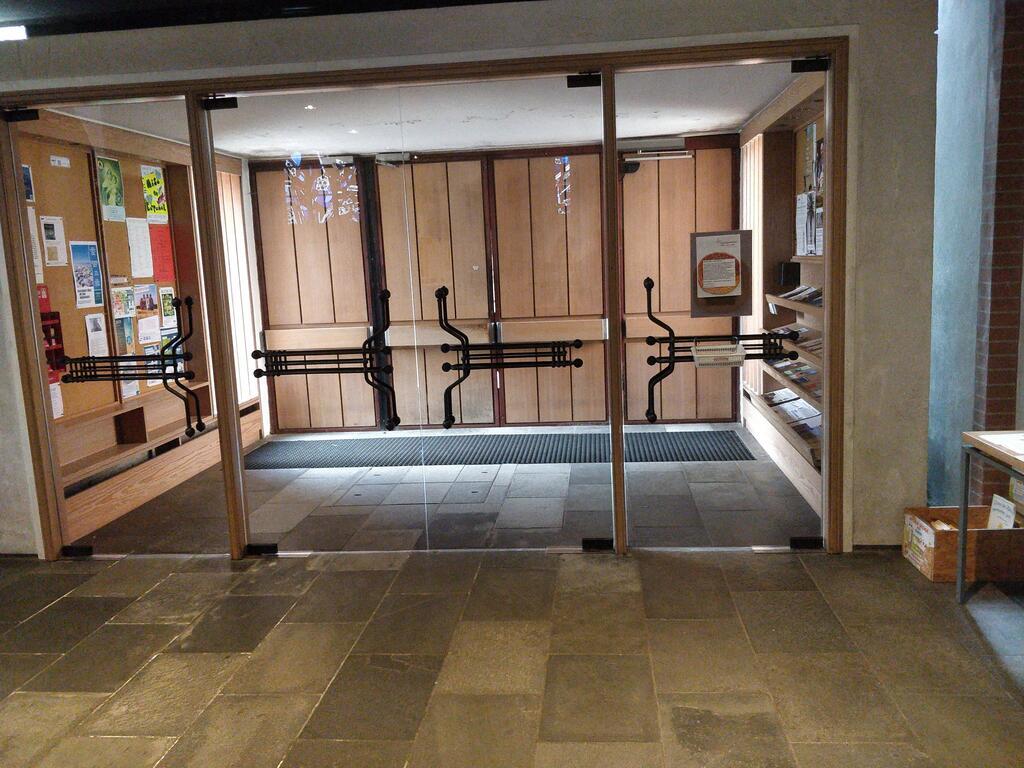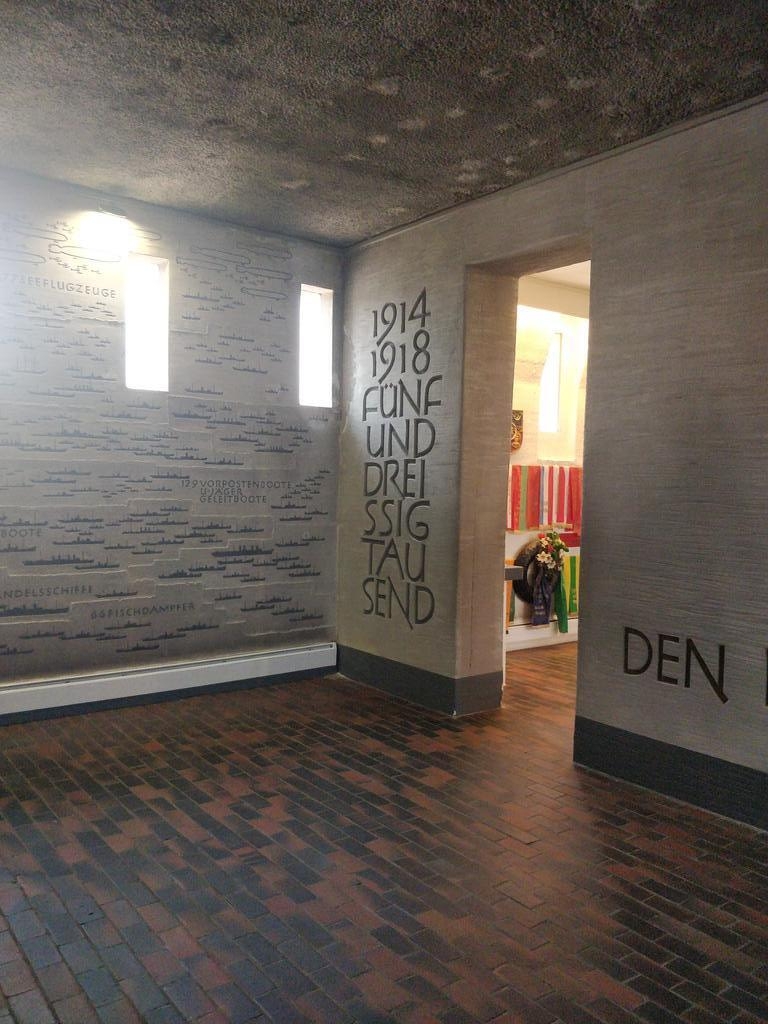Summer 2019, first step : Kiel, Germany
First step : Kiel, Germany.
Thursday, the 18th of June
During my first day, I rounded Kiel downtown. There are not so much more of the old town, which is a sad thing.

Designed glass doors to a church.
But I could visit three very interesting museums, two of them for free. The first one was an art museum. Some of its paintings would be to remember tomorrow.


Paintings inspired from the Laboe Memorial, which I am to visit tomorrow.
Zoological Museum
Second museum in Kiel : zoological museum. The entrance fee is 4 € for an adult. Totally worth it.
One can see skeletons from all sorts of animals. Even without understanding much (everything is in Deutsch, only a few texts are doubled in English), it’s still fascinating.

Giant anteaters.

An orca’s skeleton.

A whale’s skeleton.

The skeleton of a sperm whale.
One can learn about sharks’ revolver teeth, birds’ feather or the (left) tooth of the narval.

The shark’s teeth mechanism. Or how to never again being dragged to the dentist. Cool.
Kiel naval museum
I did not take that much pictures here.
The naval museum had an exposition on the German revolution of 1918, which lead to :
- the end of the World War I, on the German side
- the end of the German Empire and its constituent monarchies
- the end of pre-1914 German militarism
- the founding of the Weimar Republic
- the beginning of the pre-1945 German militarism (because the roots from the previous were not expunged and no cultural work had been done).
Just that.

The revolution began with minor strikes in German war ports. The sailors are locked in Kiel and Wilmenhaven and did not actually have real involvement in the conflict, but their living conditions (and those of their families) where getting worse and worse with rationing. One day is one too much, sailors strike in Wilmenhaven. Those from Kiel wish to support them. And so it began.
This relatively small conflict, by means of the political game, and while the war still rages outside, shall crystallise the hopes for change in Germany : freedom and social mobility, freedom for women, etc.
By a domino effect, all the monarchs of the country abdicate, one by one.
One can also see the stab in the back myth, on which was founded the Weimar Republic, and which will cause its loss: the American president, Wodrow Wilson, asking an elected government to declare peace and signing the treaties, will allow the military to deny their responsibility and push it on the new government - civilian - who must then swallow it, even though it was the military who ruled the country - and maintained war economy - from 1916 to 1918, and were therefore responsible for famine among civilians (800 000 deaths among German civilians due to malnutrition).
Nobels Alley
Kiel has a few Nobel prices, and it proudly say so.

Further away, an industrial sculpture might be a memorial to the 1918 revolution (a model is presented in the exposition but the explanation being in German, I did not understand a word of it).

Friday, the 19th of June
The second day was dedicated to the Laboe naval memorial. Here we can see the huge cultural work made in Germany (cultural work that lacked previously at the beginning of Weimar Republic).
The memorial (and neighboring submarine) are not to be seen in Kiel but at the end of the fjord, some 20 km away from downtown. All photos are to be seen here.
U995

I was looking forward to this visit, and I must admit I was not at all disappointed.
This submarine is indeed a true marvel of engineering. On the whole length of the vessel, a unique corridor, with sealing hatches. Space is used at peak efficiency.



Diesel engines and speed indicators.


The kitchen and the toilets
One needed truly not to be afraid of closed spaces. Nor to high. Because doors and beds were both small.
There were enough levers, cranks and valves of all kinds to wonder if the guys could really control their engine. A little disappointed that we can not climb the massif or the bridge.
Laboe Memorial

This memorial was first and foremost built in memory of German sailors killed during WWI. Later were included Allies from WWII (yes, Americans and French alike are presented there) and finally the memorial became a symbole of peace and free navigation at sea.


The Prinz Eugen propeller.
The memorial is actually a red brick architectural complex with a giant tower, a low building housing model warships and portico pillars that connect everything together. It’s ultimately very zen for a war memorial. A wise choice therefore, since it aims today, to reflect on war. And to look at it rationally, rather than igniting and seeking revenge.

The memorial circle. The background portico is actually the building where models are exposed.

One of the numerous models, here a vessel from Nazi Germany.
The basement of the memorial is a circular hall with flags of Western countries (including neutral) having taken part in the war with Germany. So there are France, Denmark, Sweden, Latvia … but not Japan (I think). In the center, a flame to the unknown sailor (I think). Take what I say with caution there, I did not understand the plates around the monument.

A flame to the unknown sailor.

At the ground level of the tower, a hall present the huge amount of men and vessels engaged in the two world wars.




The various navies of the world send their flags.
Climbing the tower turned out to be a mental strength test. Because in fact … it’s high. And it’s almost terrifying. Although I did not want to jump, I still clung to the guardrail. On the wall side.

It’s slightly terrific.
The view from the top is simply splendid. The submarine looks to be so tiny. According to the plaque, one can see Denmark from there (actually just a small piece of it).


Left photo : this is not Denmark but just the end of Kiel’s bay. Denmark (Sonderborg) should be in the deep background. Right photo de droite : the submarine, seen from the top of the tower.
I took the elevator down.
All pictures from Kiel are here. Il y en a bien plus que ce que je pouvais mettre dans l’article.